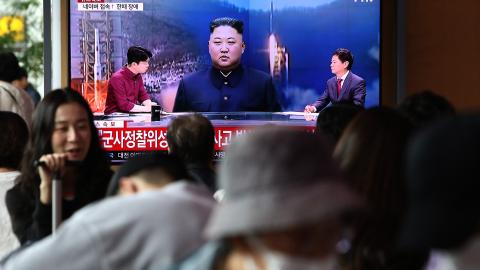Pyongyang’s repeated threats to shoot down U.S. reconnaissance aircraft may be more than idle words.
North Korea alleges that an American intelligence plane breached the “inviolable airspace” of the Kim regime on Monday. The defense ministry menacingly offered that “there is no guarantee” that North Korea won’t shoot down future reconnaissance aircraft. A “shocking” incident is possible, according to Kim Yo Jong, sister of North Korean leader Kim Jong Un.
Pyongyang is conflating the international legal distinction between a nation’s 12-nautical-mile sovereign territory and airspace and its 200-nautical-mile exclusive economic zone (EEZ). Even so, there is precedent for attacking U.S. intelligence platforms operating in international airspace and waters. U.S. and allied pilots and ship captains should brace for the possibility of hostile action.
In April 1969, a single North Korean Air Force MiG-21 fighter downed a Navy EC-121 signals intelligence aircraft operating 80 miles off North Korea’s coast. All 31 crewmen aboard the plane perished, and North Korea’s warning chillingly references this half-century-old incident. Importantly, the United States took no retaliatory moves against either the EC-121 shoot-down incident or the seizure of the USS Pueblo intelligence vessel in international waters in January 1968.
Kim undoubtedly would like to find new coercive measures that would fall short of triggering a harsh military response.
Of course, these are different times. Both the Pueblo and the EC-121 incidents occurred during the so-called Second Korean War, a turbulent period in the late-1960s when Kim Il Sung instigated lethal crises with the hope of sowing rebellion within then-authoritarian South Korea.
These days, threatening pronouncements are a customary, low-cost weapon the Kim regime employs.
Only occasionally are broadsides matched by malign actions. For instance, the costly hack of Sony Pictures in 2014 occurred on the heels of North Korea declaring the Hollywood movie “The Interview,” a dark comedy about a plot to assassinate Kim Jong Un, “an act of war.”
We can certainly dispute North Korea’s claim that U.S. aircraft are operating within its airspace, and the Pentagon is adamant that American pilots are adhering strictly to international law. We can also remain skeptical about whether this latest threat constitutes the true intention to enact another threat of violence from Pyongyang.
But we must consider the possible motives for this specific threat now. Five plausible explanations may reveal what the Kim regime thinks.
First, a dictatorship can never have enough control. COVID has left North Korea even more isolated, and the policy of pursuing nuclear weapons and economic development simultaneously (known as "Byungjin") is only delivering on half of its promise. Facing widespread hunger and financial woes, this is a moment when the Kim family needs to rally people against Pyongyang’s main nemesis, the United States.
A second rationale for speaking out may be to project strength abroad. Vladimir Putin appeared to have a lock on power in Russia before cracks materialized last month. North Korea has no Wagner Group to fear. But North Korea has faced a few notable instances of factionalism. The most recent was in 2013, when Kim felt the need to execute his uncle Jang Song Thaek, then the second-most powerful man in the country.
North Korea’s need for attention amid this month’s high-level diplomatic conferences is another reason for the latest taunt. From the NATO summit in Vilnius to the ASEAN Regional Forum meeting of foreign ministers in Jakarta, consequential negotiations are happening without North Korea. That’s a stark contrast to when Kim Jong Un enjoyed the spotlight on the international stage five years ago.
A fourth reason for threatening a takedown is to neutralize some of the recent successes of the 70-year-old U.S.-South Korea alliance. Next week, the allies will hold the inaugural meeting of the nuclear consultative group, a new mechanism designed to strengthen extended deterrence that was announced in April by Presidents Biden and Yoon Suk-yeol. Toward the end of the month, near the anniversary of the 1953 Armistice, a U.S. ballistic missile submarine will dock in a South Korean port for the first time since the Reagan administration. North Korea will be keen to spoil these alliance milestones. Monday’s ICBM launch was a predictable move, but North Korea may still up the ante.
A fifth reason is more ominous than the others. There is a possibility that the charge of “provocative aerial espionage,” a phrase sure to resonate with China’s narrative about U.S. military operations, could be a pretext for an impending provocation. If there is to be a kinetic action and not simply a political warfare gambit for psychological effect, taking down U.S. aircraft and ships operating near North Korea are in Pyongyang’s crosshairs.
At a minimum, North Korea wishes to draw a bright line of forward deterrence to ensure the United States and South Korea keep their distance and come no closer to a regime that, while nuclear-armed, is hobbled by severe doubts. More aggressively, Kim may feel the moment is ripe for a more aggressive show of limited force. North Korea cannot be taken at its word, but it does need to be taken seriously.















